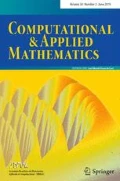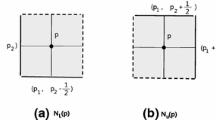Abstract
To digitize subspaces of the Euclidean \(n\)D space, the present paper uses the Khalimsky (for short \(K\)-, if there is no danger of ambiguity) topology, \(K\)-adjacency and \(K\)-localized neighborhoods of points in \(\mathbf{Z}^n\), where \(\mathbf{Z}^n\) represents the set of points in the Euclidean \(n\)D space with integer coordinates. Namely, given a point \(p \in \mathbf{Z}^n\), the paper first develops a \(K\)-localized neighborhood of \(p \in \mathbf{Z}^n\), denoted by \(N_K(p)\) in \(\mathbf{R}^n\), which is substantially used in digitizing subspaces of the Euclidean \(n\)D space. The recent paper Han and Sostak in (Comput Appl Math 32(3):521–536, 2013) proposes a connectedness preserving map (for short CP-map, e.g., an \(A\)-map in this paper) which need not be a continuous map under \(K\)-topology and further, develops a certain CP-isomorphism, e.g., an \(A\)-isomorphism in this paper. It turns out that an \(A\)-map overcomes some limitations of both a \(K\)-continuous map and a Khalimsky adjacency map (for brevity \(KA\)-map) so that both an \(A\)-map and an \(A\)-isomorphism can substantially contribute to applied topology including both digital topology and digital geometry Han and Sostak in (Comput Appl Math 32(3):521–536, 2013). Using both an \(A\)-map and a \(K\)-localized neighborhood, we further develop the notions of a lattice-based \(A\)-map (for short \(LA\)-map) and a lattice-based \(A\)-isomorphism (for brevity \(LA\)-isomorphism) which are used for digitizing subspaces of the Euclidean \(n\)D space in the \(K\)-topological approach. Thus, this approach can contribute to certain branches of applied topology and computer science such as image analysis, image processing, and mathematical morphology.









Similar content being viewed by others
References
Alexandorff P (1937) Diskrete Räume. Mat Sb 2:501–518
Cech E (1966) Topological spaces. Revised by In: Frolik Z, Katetov M (eds) Academia, Prague
Chatyrko VA, Han SE, Hattori Y (2014) Some remarks concerning semi-\(T_{\frac{1}{2}}\)-spaces. Filomat 28(1):21–25
Fujimoto M, Takigawa S, Dontchev J, Noiri T, Maki H (2006) The topological structure and groups of digital \(n\)-spaces. Kochi J Math 1:31–55
Han SE (2005) Non-product property of the digital fundamental group. Inf Sci 171(1–3):73–91
Han SE (2008) Continuities and homeomorphisms in computer topology and their applications. J Korean Math Soc 45(4):923–952
Han SE (2008) Equivalent \((k_0, k_1)\)-covering and generalized digital lifting. Inf Sci 178(2):550–561
Han SE (2008) The \(k\)-homotopic thinning and a torus-like digital image in \({ Z}^{n}\). J Math Imaging Vis 31(1):1–16
Han SE (2010) KD-\((k_0, k_1)\)-homotopy equivalence and its applications. J Korean Math Soc 47(5):1031–1054
Han SE, Sostak A (2013) A compression of digital images derived from a Khalimksy topological structure. Comput Appl Math 32(3):521–536
Khalimksy ED (1970) Applications of connected ordered topological spaces in topology. Conference of Mathematical Department of Provoia
Khalimksy E, Kopperman R, Meyer PR (1990) Computer graphics and connected topologies on finite ordered sets. Topol Appl 36(1):1–17
Kong TY, Rosenfeld A (1996) Topological algorithms for the digital image processing. Elsevier Science, Amsterdam
Melin E (2007) Digital surfaces and boundaries in Khalimksy spaces. J Math Imaging Vis 28:169–177
Ronse C, Tajine M (2000) Discretization in Hausdorff spaces. J Math Imaging Vis 12:219–241
Rosenfeld A (1979) Digital topology. Am Math Mon 86:76–87
Šlapal J (2008) A quotient-universal digital topology. Theor Comput Sci 405:164–175
Šlapal J (2009) Convenient closure operators on \({ Z}^2\). Lect Notes Comput Sci 5852:425–436
Author information
Authors and Affiliations
Corresponding author
Additional information
Communicated by Jinyun Yuan.
This research was supported by Basic Science Research Program through the National Research Foundation of Korea (NRF) funded by the Ministry of Education, Science and Technology (2013R1A1A4A01007577).
Rights and permissions
About this article
Cite this article
Han, SE. A digitization method of subspaces of the Euclidean \(n\)D space associated with the Khalimsky adjacency structure. Comp. Appl. Math. 36, 127–144 (2017). https://doi.org/10.1007/s40314-015-0223-6
Received:
Revised:
Accepted:
Published:
Issue Date:
DOI: https://doi.org/10.1007/s40314-015-0223-6
Keywords
- Digitization
- Digital topology
- Khalimsky \(n\)D space
- Khalimsky adjacency
- \(A\)-map
- \(A\)-isomorphism
- Local rule
- \(K\)-localized neighborhood
- \(LA\)-map
- \(LA\)-isomorphism
- Mathematical morphology




